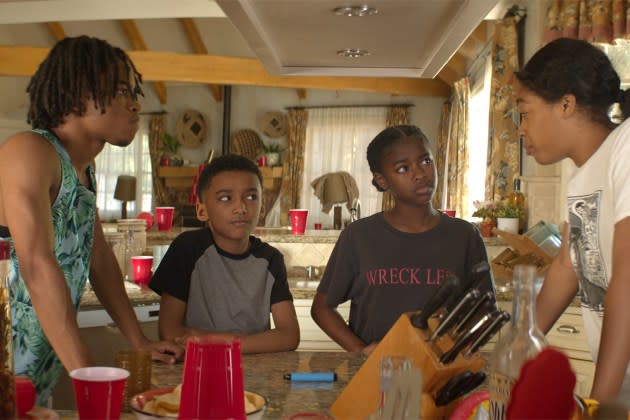‘Don’t Tell Mom the Babysitter’s Dead’ Review: A Remake That Remarkably Refashions Secondhand Goods

Within its first few minutes, director Wade Allain-Marcus’ “Don’t Tell Mom the Babysitter’s Dead” proves a worthy remake. Putting a modern comic spin on its ’90s counterpart’s opening sequence, it sets up our young heroine for a rude awakening and an indelible coming-of-age journey. By rearranging a few key details, losing some vestigial supporting characters and refocusing the story on a Black family learning to come together, the proceedings gain hilarity, buoyancy and resonance. Genuinely funny, charming and sincere, it’s a respectful and revelatory update in a world where those are few and far between.
Seventeen-year-old Tanya Crandell (Simone Joy Jones) is in for the summer of her life — only not the one she planned. She’s been looking forward to a two-month trip to Spain with her besties to blow off steam. However, this rapidly changes once her widowed mom (Patricia “Ms. Pat” Williams) has a nervous breakdown at work and needs Tanya’s vacation funds for a medically mandated, immersive yoga retreat in Thailand. But the worst news is yet to come. Mom has hired a babysitter to watch over Tanya and her siblings: burn-out Kenny (Donielle T. Hansley Jr.), macabre Melissa (Ayaamii Sledge) and naive Zack (Carter Young).
More from Variety
Sara and Erin Foster's Favorite Daughter Fashion Label Lands in Beverly Hills; Plus More Style News
Annie Gonzalez, Sofia Capanna Join ABC Comedy Pilot 'Bucktown'
Nonagenarian Ms. Sturak (June Squibb) isn’t the sweet old caretaker the kids expected. She’s unabashedly racist and rude. Thankfully her tyrannical reign comes to an abrupt end, as she expires in her sleep the first night. The savvy siblings must band together not only to dispose of the body (in a sequence with a solid self-aware joke at the expense of the 1991 film), but also to survive without cash or a guardian — and without disrupting their mother’s sanity. Tanya quickly learns she can’t get by on gig employment, so she forges her résumé to work at a flailing fashion company for the fabulously cool Rose (Nicole Richie). Yet just as things start to look up for the Crandells, they suffer a series of significant setbacks that land them in trouble.
Screenwriter Chuck Hayward masterfully reworks the blueprint drawn by originating screenwriters Neil Landau and Tara Ison (who also earn executive producer and story credits). Thematically, he and Allain-Marcus wisely focus further on familial ties, not solely by giving each individual Crandell meaningful arcs (eliminating one dysfunctional sibling from the original altogether), but also by highlighting how the siblings work as a team to beat the odds and defy societal expectations set for youths. The film also improves upon the original when it comes to Tanya’s co-workers Caroline (Iantha Richardson) and Bruce (Gus Kenworthy), who are no longer just bitchy antagonists, but rather more multi-faceted in their narrative function.
The filmmakers shrewdly incorporate timely topics like fast fashion, food insecurity, toxic masculinity and privilege in a humorous, intelligent manner. The juvenile shenanigans that provide conflict are filled with tension — as predicaments like breaking an arm and dealing with cops are very different scenarios from the perspective of the Black Crandells as compared to their white predecessors.
Nostalgic nods to the original are deftly executed, with cameo appearances, quotable lines and soundtrack cues all placed with precision. While many of the first feature’s memorable squeeze zooms, close-ups, sharp edits and wardrobe accents are included as callbacks for eagle-eyed fans, Allain-Marcus and his team also apply their own signature aesthetic flourishes. A late title card drop hints that we’re in for a cool, creative mashup. Matt Clegg’s cinematography evokes tender romanticism when Tanya and her crush Bryan (Miles Fowler) are on dates, while there’s youthful fluidity in the camera movement, particularly when the family is gracefully circled during a second-act dinner scene. Production design on the Crandell house — filmed at the same Santa Clarita home as the original — reflects the family’s evolving state of togetherness, going from disrepair to gussied-up polish.
Jones nimbly negotiates her character’s awkward moments with vulnerability and impeccable comic timing. Hansley Jr. gives Kenny depth and dimension, while Young — handed a hilarious subplot as Zack befriends a murder of crows — and Sledge give star-making turns of their own. Richie genuinely sparkles in the role of Rose, talking in the delightfully-hurried pace of Rosalind Russell as if starring in her own ’40s-inspired screwball comedy.
A few gags fall flat (including one mention of factory-worker suicides) and there’s a nothingburger C-storyline involving Rose’s slimy paramour Gus (Jermaine Fowler), but the positive changes overshadow the flaws. Also notable is a sly commentary on the remake process itself: Eco-minded Tanya takes a sustainable approach to her job, creating chic wardrobes from upcycled fabrics and garments. Like the filmmakers, she takes the good parts of what was and fashions something fresh and fun for contemporary times.
Best of Variety
Sign up for Variety’s Newsletter. For the latest news, follow us on Facebook, Twitter, and Instagram.

 Yahoo Movies
Yahoo Movies 